AMD Radeon HD 7870 GHz Edition & Radeon HD 7850 Review: Rounding Out Southern Islands
by Ryan Smith on March 5, 2012 12:01 AM ESTPower, Temperature, & Noise
As always, we wrap up our look at a new video card with a look at the physical performance attributes: power consumption, temperatures, and noise. Thanks to TSMC’s 28nm process AMD has been able to offer 6900 series performance on a much smaller chip, but what has that done to power consumption and all of its related properties? Let’s find out.
Please note that we’re including our 7870-based 7850 in these charts, even though none of AMD’s partners will be shipping a card in this exact configuration. Power consumption should be nearly identical to shipping cards, but temperatures and noise readings are going to be significantly different since most of those cards will be using open air coolers.
| Radeon HD 7800 Series Voltages | ||||
| Ref 7870 Load | Ref 7850 Load | Ref 7870 Idle | ||
| 1.219v | 1.213v | 0.85v | ||
When getting a voltage reading on our 7800 cards through GPU-Z, it was interesting to note that the load voltage was almost identical between the two cards: 1.219v versus 1.213v. While we believe GPU-Z is giving us the right readings, we’re not sure whether the 7850 voltages are the same we’ll be seeing on shipping cards because of the PCB differences.

Idle power consumption looks quite good, as you’d expect from GCN. Idle power consumption is virtually identical to the 7900 series at the wall, and only the 7700 series can beat 112W. This further goes to show just how much progress has been made with idle power consumption – the Cayman based 6900 series had good idle power consumption for its time, and yet the 7800 series beats it by 5W+ at the wall.
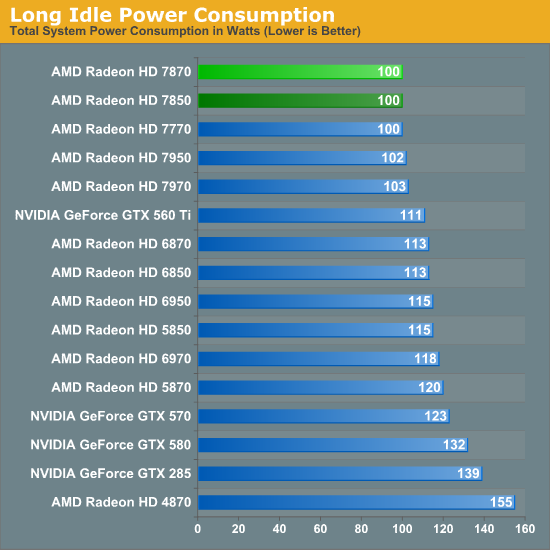
Long idle power consumption is virtually identical with the rest of the Southern Islands cards thanks to AMD’s ZeroCore Power technology. The next closest card is the GTX 560 Ti, and that’s at nearly 10W higher.
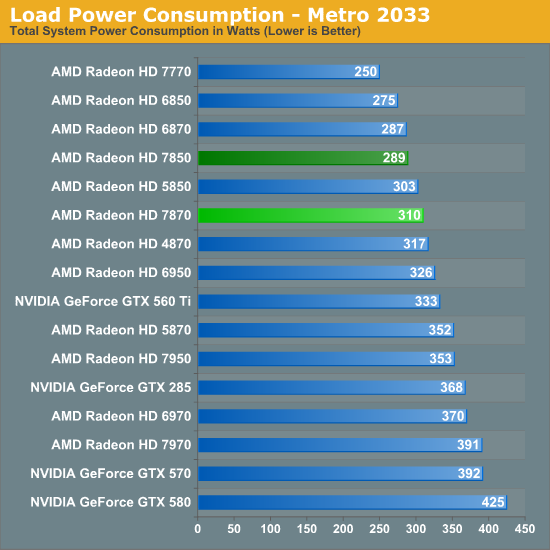
Moving on to load power testing, we have Metro 2033. Load power consumption here is about where you’d expect it to be, with the 7800 setups drawing more at the wall than the 6800 setups, but less than the 7900 and 6900 series. This is largely a consequence of performance, as the higher rendering performance of the 7800 series versus the 6800 series drives up CPU power consumption in order to generate more frames.
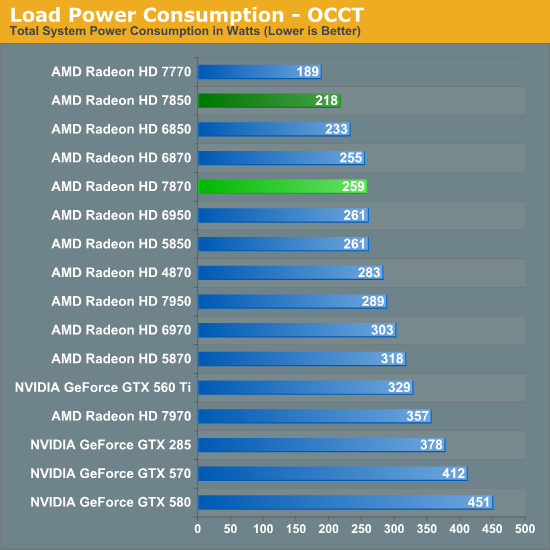
OCCT on the other hand gives us a more purified look at power consumption, and as you’d expect for 28nm it looks good. The 7870 ends up drawing only a few more watts at the wall compared to the 6870, showcasing the fact that the 7800 series is a drop-in replacement for the 6800 series from a power consumption perspective. The 7850 looks even better, capping out at 15W below the 6850, most likely as a result of PowerTune keeping the card firmly at 150W. Though it’s interesting to note that the measurements at the wall don’t perfectly align with the differences in PowerTune limits, with the 7850 drawing 30W more than the 7770 at the wall compared to a 50W PT difference, while the 7950 draws 30W more at the wall over the 7870 even though there’s only supposed to be a 10W PT difference.
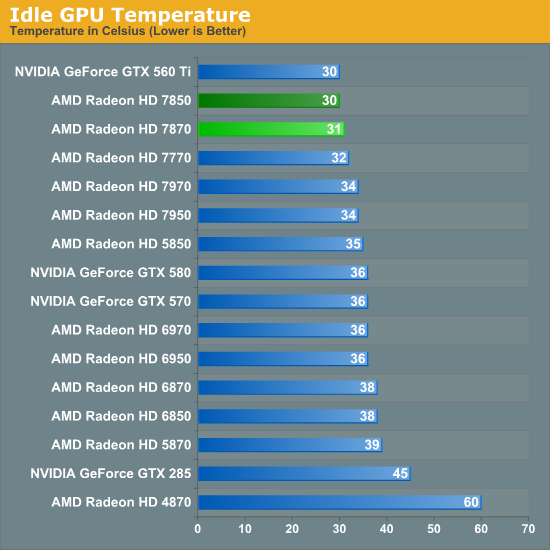
AMD’s latest generation blowers do quite well with idle temperatures and we can see it here. At 30C for the 7850 it’s every bit as cool as the GTX 560 Ti, while the entire 7800 series is around 5-8C cooler than the 6900.
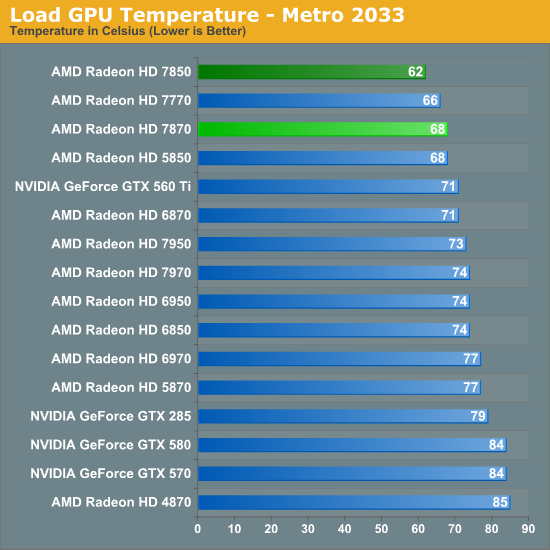
Under load, Metro temperatures are also quite good. At 62C the 7850 is the coolest card in this performance class, but keep in mind that it’s basically using an oversized cooler; retail cards will be open air coolers with much different characteristics. Otherwise at 68C the 7870 is still among the coolest cards, coming ahead of even the historically cool GTX 560 Ti, never mind the much hotter 6900 series.

Load temperatures climb under OCCT, but again the 7800 series is among the coolest temperatures we see. Here we see the 7870 peak at 73C, whereas its last generation counterpart would be at 80C and the GTX 570 at a toasty 87C.
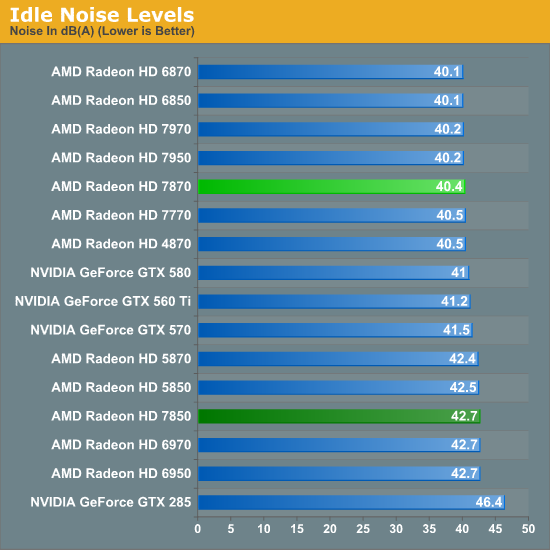
Moving on to noise testing, there are no major surprises at idle, with the 7870 hugging 40db. For whatever reason the 7850’s minimum fan state is roughly 200RPM higher than the 7870’s, but since no one will be using this cooler it’s not a significant result.
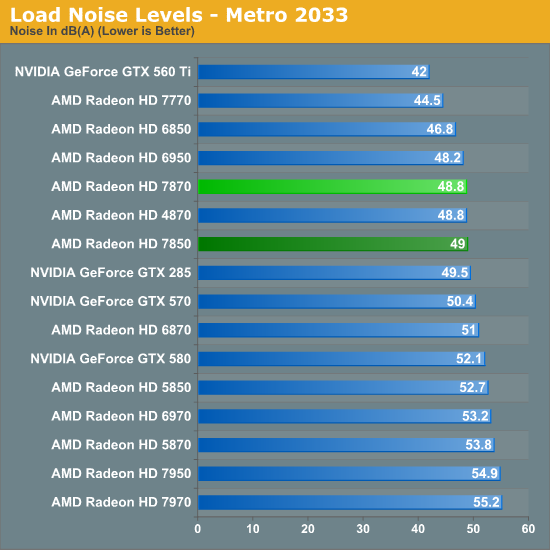
Consistent with AMD’s other 7000 series cards, we’re once again seeing the consequences of AMD’s aggressive cooling policies coupled with the use of a blower. At 48.8dB the 7870 is still quieter than the blower-based 6870, but it’s significantly louder than the open air cooled GTX 560 Ti, even though the latter consumes far more power and generates far more heat. This doesn’t make the use of a blower the wrong choice, but combined with aggressive cooling policies it does hurt AMD. The GTX 570, in spite of using much more power than the 7870, is only less than 2dB louder even though it too uses a blower.

Last, but not least we have our OCCT noise results. Unlike Metro the 7800 series does better on a relative basis here, but this is mostly because NVIDIA doesn’t have a power throttling system quite like PowerTune. At 51.9dB the 7870 is not the quietest card, but it still manages to beat the 6970 and the PowerTune-less 6870.
All things considered there are no great surprises here on a relative basis, as the 7800 series performs like we’d expect for a blower based sub-200W video card. Due to TSMC's 28nm process AMD greatly improves on their performance/power and performance/noise ratios with the 7800 series compared to the 6800 and 6900 series, while for their power class the 7800 series is slightly ahead of the pack on both power consumption and noise.
With that said, keep in mind that since most of AMD’s partners will be using open air coolers these results won’t be applicable to most retail cards. So for the temp/noise characteristics of retail cards you’ll want to look at individual card reviews when those start appearing later this month. This is particularly true for the 7950, where all of the retail cards will be using a different design than our sample.










173 Comments
View All Comments
Exodite - Tuesday, March 6, 2012 - link
I have absolutely no problem with that.The apt comparison would be the 7900 series though, and those only really fail on price.
Which will likely change if Nvidia brings something competitive to the high end with Kepler.
Lets face it, until the current consoles die in a fire and/or display makers see fit to bring sensibly priced >1080p panels to the desktop there's really no need for more performance in the desktop space.
SlyNine - Monday, March 5, 2012 - link
The fact the things are sitting still.I'm running a 5870 which is basically 75% the performance of a 7970, and I paid 379 for the 5870. Which is also 75% of the cost of a 7970. The price of a 7970 is basically the exact same price structure as the 2 1/2 year old 5870, So we are stuck where we were in 2009, yay.
This is NOT how the computer world is supposed to work, and as big geek, I don't like it.
morfinx - Monday, March 5, 2012 - link
75% performance of 7970 would mean that it's 33% faster than a 5870. And that's just not accurate. I have a 5870 as well, so I was paying a lot of attention on how much faster the 7970 is in various reviews. Everything I've read indicates that it's anywhere from 70-110% faster at 2560x1600 resolution (I run 3600x1920, so likely even even more of a difference). That's not even even considering the massive overclocking headroom of the 7970 vs barely any OC headroom of the 5870. Overclocked, a 7970 is easily twice as fast as a 5870.Alpert - Tuesday, March 6, 2012 - link
The 6950 retailed for $299 and the 6970 retailed for $369 when they were released. 10-25% performance increase for every new series of cards is what to expect. Now we can clearly see these card perform better then the 6950/6970, hell a 7850 overclocks to what a GTX580 is capable of.The value of what was a $600 GTX580 card more then a year ago, The value of a $499 GTX580 today, you get a $300 7850.
The price you pay for performance is always going down just not in big steps.
Logsdonb - Monday, March 5, 2012 - link
These should be excellent cards for crossfire solutions, especially when combined with the new PCI 3.0 bus system. They represent significant improvements in heat, power, and noise at their performance levels. I think these would work well in small form factor gaming PCs, especially when combined with the upcoming Ivy Bridge CPUs, which max out at 77 watts. I don't want a loud, space heater that sucks down massive power for a computer. I have also noticed that cooler systems tend to last longer and have few problems. I feel confident that the prices will come down once the competition from Nvidia comes out next month.I am thinking that we are approaching a really nice time to upgrade if you like balanced systems that deliver excellent gaming performance in reasonable portable packages that wont disturb your personal environment with excess heat and noise. I intend on waiting for Ivy bridge and Kepler before pulling the trigger, but I am eagerly awaiting upgrading evertyhing.
claysm - Monday, March 5, 2012 - link
The price point on the 7xxx series cards seems to be a little too high at the moment, the only advantage they have is that that do outperform the GTX 5xx series cards in a number of ways (power consumption, performance, temps). The biggest problem with the 7xxx series is that they just don't perform that much higher at each price point than AMD's current 6xxx series cards. Why get a 7770 when you can, for the same money and MUCH more performance, get a 6870? The prices will drop when Kepler rolls around I'm sure, but for now, a little too high, given that most of the increases at each price point don't come in the realm of performance.CeriseCogburn - Thursday, March 8, 2012 - link
AMD has been listening to their little screaming fans who wailed that electric usage and core temps are all the rage....So now the amd fans need to PAY UP SOME $$$ for the nice electric consumption and core temp reduction... let's face it - they have told us all for years now those two things alone are well worth a purchase decision, PERIOD.
I guess it's time for them to dig down deep since their Master has responded with everything they declared of utmost importance.
What's wrong AMD fans ?
BrightCandle - Monday, March 5, 2012 - link
I would love to see Anandtech start to look into the stutter/inconsistent frame problems with these modern graphics card reviews. The techreport has been doing a good job in blowing the lid on the problem, but you guys should be able to start to apply pressure to AMD/NVidia to improve the situation. The minimum average is not the worst it can be, the worst frame time is what you need to worry about. Averages over a second just aren't accurate enough.loeakaodas - Monday, March 5, 2012 - link
These look like great performing cards that need a $50~$100 price drop & hopefully nVidia's new offering will force AMD to compete like they did with the legendary 4800 & 5800 series. I was hoping for a sensible upgrade path from my 2x5850's but it doesn't look like that exists yet, at least not at these price points. I'm better off of putting that money towards a large SSD upgrade, otherwise this midrange 2.5 year old system doesn't really beg for an upgrade.ET - Monday, March 5, 2012 - link
The OC 7850 beats everything hands down at the 2560x1600 resolution, which doesn't look right considering the rest of the benchmarks.Also, on the Skyrim benchmark page the writeup has "GPUs GPUs" on it.